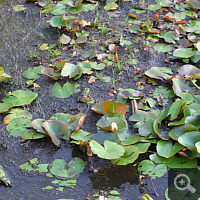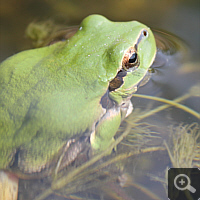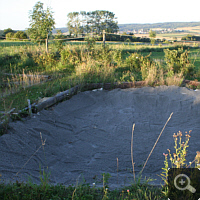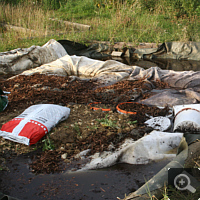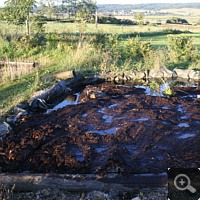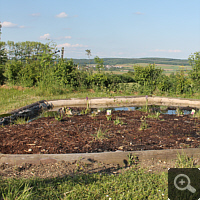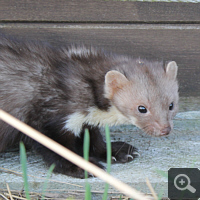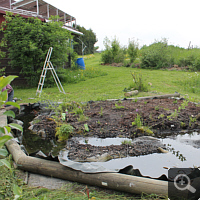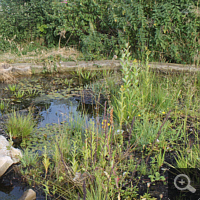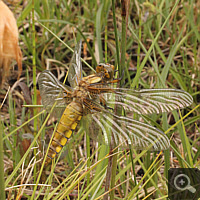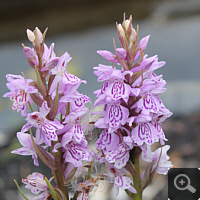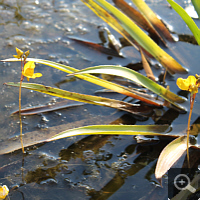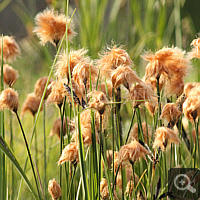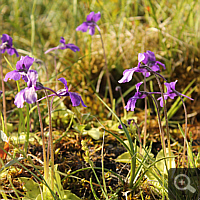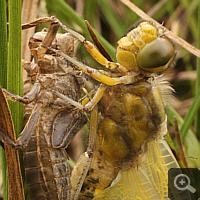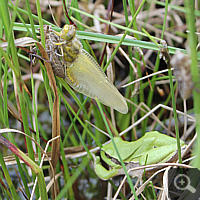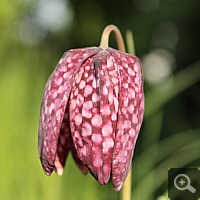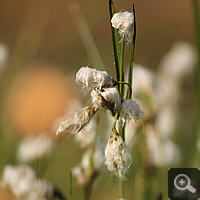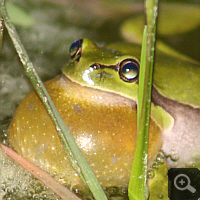
Fen Bed
Overview
Stagnant waters show in the long run a tendency to silting up, if they are not permanently fed and drained by water, which flushes away depositing sediments. On the one hand a continuous reduction of the depth of a body of water occurs by sedimentation, in addition the water silts up from waterside to centre. At first a reed bed emerges, which is characterized especially by bulrushes and reeds. Later settle additionally sedges, rushes and Cotton Grasses. The water evolves by silting up from a reed bed to a fen, which still is fed by groundwater and as a consequence still shows a higher mineral and nutrient content. Fens are very species-rich biotopes. They host numerous orchid species, in addition as carnivorous plants butterwort and bladderwort species. Furthermore are here to be found Buckbean, Bird’s-eye primrose, Globeflower and gentian species, to name but a few plants.
Project
Explanation of construction and schematic representation
The basic principles of the construction of a bog bed I have already described on the site ‚raised bog bed‘. Also a fen bed does not materially deviate from these principles. Also here is the installation of a distinct internal water reservoir obligatory. An open water reservoir in the form of a small pond for example for the cultivation of native bladderwort species is useful, but not mandatory.
In two points a fen differs crucially from from a raised bog. On the one hand in ph-value, on the other hand in nutrient content. Whereas a raised bog is very acid (ph-value < 4) and extremely low in nutrients, the pH-value of a fen is around 7 and the nutrient content is there significantly higher.
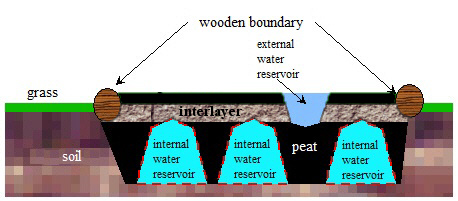 Of course, these differences must be considered at the laying out and the subsequent cultivation of the fen bed. The intermediate spaces of the bog bed are filled with raised-bog peat too. Then follows a 10 – 15 cm high calcareous and nutrient-rich interlayer. This layer should be mixed of circa 50% peat, 25% calcareous, sharp sand and 25% lime chippings. Finally follows a thin surface layer of peat or partly bark mulch.
Of course, these differences must be considered at the laying out and the subsequent cultivation of the fen bed. The intermediate spaces of the bog bed are filled with raised-bog peat too. Then follows a 10 – 15 cm high calcareous and nutrient-rich interlayer. This layer should be mixed of circa 50% peat, 25% calcareous, sharp sand and 25% lime chippings. Finally follows a thin surface layer of peat or partly bark mulch.
The bed should be cut annually in autumn and the clippings should rest on it for some days, so that potentially still existing seeds can sow themself. Then the clippings is cleared. Because by mowing nutrients are extracted out of the fen bed, these have to be added again in the form of a fertilisation with a potassium and phosphor accented fertiliser in April and in summer. You can counteract a surficial acidification with the sparingly application of Dolomite lime in autumn.
Suitable plants for an all-year outdoor culture
To different tables with plants with plants, which are suitable for an all-year outdoor culture within a bog bed, you get here.
Development
2013
The fen bed shows in the first year a pleasant development. The in the previous year bought orchids blossom well and have reproduced partly by stolons. Most sown species are germed. The Water-soldier (Stratiotes aloides) and the Southern bladderwort (Utricularia australis) grow almost rapant within the open surfaces of the water and please by myriad blossoms. Midyear grow all in all 24 plant species within the bed.
Also faunistic is the bed a success. Already a few weeks after construction were skimmers and water-scavenger beetles to be found. Larvae of different insect species splash about in water, what represents an eldorado for the bladderwort. In this spring are furthermore some Alpine newts (Ichthyosaura alpestris) immigrated and have accepted the bed as their hatchery.
During the very hot July I have to refill once water, apart from that self-regulation of the water supply was going very well so far.
2014
Also the second year proved gratifying. In particular, the cotton grasses multiplied by stolons. Likewise, the water soldier (Stratiotes aloides) sprawled. The large-flowered butterwort (Pinguicula grandiflora) increased twentyfold its inventory. The orchids, however, suffered a little under slug damage.
The Alpine newt (Ichthyosaura alpestris) spawned again, many dragonfly larvae are grown to dragonflies this year. In addition, I have seen a stone marten (Martes foina) while drinking from the fen.
2015
In addition to the Alpine newt (Ichthyosaura alpestris), this year the endangered European tree frog (Hyla arborea) accepted as a second amphibian the habitat as spawning grounds. In early May hatched on sunny days in total dozens dragonflies, predominantly female Broad-bodied chasers (Libellula depressa).
In May, the Common cottongrass (Eriophorum angustifolium) and the Red cottongrass (Eriophorum russeolum) dominate the fen bed with their cotton wool-like white and orange seed heads. On this contrast dozens blossoms of the Large-flowered butterwort (Pinguicula grandiflora) and the Common butterwort (Pinguicula vulgaris).

